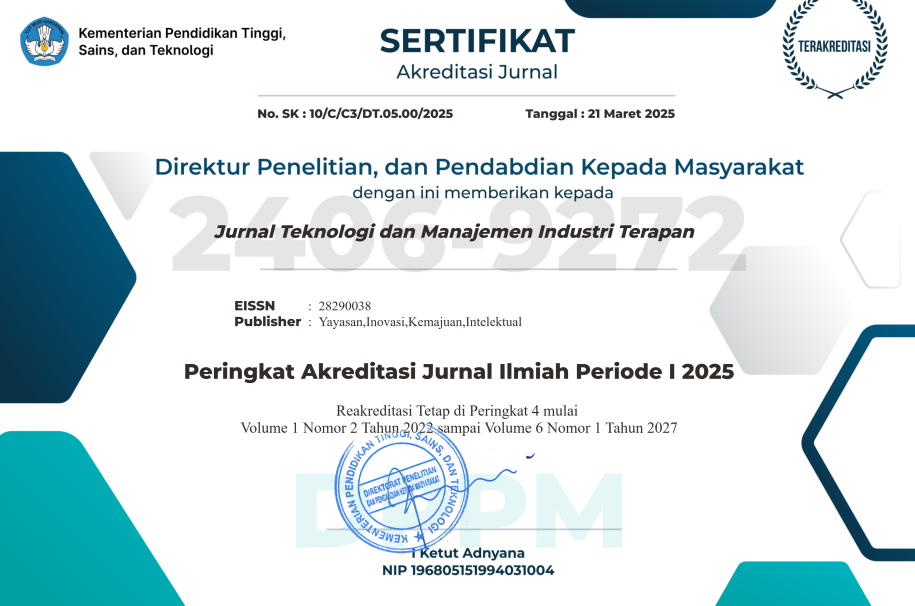A Mixed-Integer Linear Programming Model for the Rice Supply Chain in Karawang Regency to Minimize Costs
DOI:
https://doi.org/10.55826/jtmit.v4i3.1083Keywords:
Supply Chain, Rice, Mixed Integer Linear Programming, CostAbstract
The rice supply chain in Indonesia plays a vital role in national food security, where efficient distribution ensures price stability and availability in the market. However, the complexity of multi-echelon systems often leads to inefficiencies in procurement, production, and distribution. This study aims to develop a Mixed-Integer Linear Programming (MILP) model to optimize the rice supply chain in Karawang Regency, focusing on cost minimization while integrating environmental and risk considerations. Using dummy data on supply, demand, production, distribution, labor, and emissions, the model was tested with Microsoft Excel Solver. The results show that procurement from farmer groups is the largest cost component (51.24%), followed by production (23.96%) and distribution (23.19%), with a total cost of USD 1,783,113,142. Optimization achieved a 13% cost reduction and a 9% emission reduction compared to non-optimized conditions, while risk assessment identified M2–J2 supply (RPN = 20) and J1 production (RPN = 16) as the most critical hazards. These findings suggest practical implications for Perum Bulog and policymakers, including strengthening procurement planning, optimizing warehouse allocation, and adopting cleaner production technologies to improve both efficiency and sustainability. The novelty of this study lies in integrating hazard-based risk assessment with MILP for a regionally strategic rice supply chain, while simultaneously considering cost efficiency and carbon emission constraints. This provides both theoretical contributions to sustainable supply chain optimization and practical strategies for policy driven food security.
References
W. Chen and X. Zhao, “Understanding Global Rice Trade Flows: Network Evolution and Implications,” Foods, vol. 12, no. 17, Sep. 2023, doi: 10.3390/foods12173298.
S. A. S. Jifroudi, E. Teimoury, and F. Barzinpour, “Designing and planning a rice supply chain: A case study for Iran farmlands,” Decision Science Letters, vol. 9, no. 2, pp. 163–180, 2020, doi: 10.5267/j.dsl.2020.1.001.
N. Kusrini, D. Septiyarini, and W. Rafdinal, “Modelling risk of sustainable rice supply chain (SRSC) to achieve food security for emerging economies,” Journal of Modelling in Management, vol. 20, no. 4, pp. 1377–1414, Apr. 2025, doi: 10.1108/JM2-07-2024-0218.
M. J. Kazemi, M. M. Paydar, and A. S. Safaei, “Designing a bi-objective rice supply chain considering environmental impacts under uncertainty,” Scientia Iranica, vol. 30, no. 1 E, pp. 336–355, Jan. 2023, doi: 10.24200/sci.2021.55935.4481.
A. Seyam, M. EI Barachi, C. Zhang, B. Du, J. Shen, and S. S. Mathew, “Enhancing resilience and reducing waste in food supply chains: a systematic review and future directions leveraging emerging technologies,” International Journal of Logistics Research and Applications, 2024, doi: 10.1080/13675567.2024.2406555.
L. Zhou, D. Zhang, S. Li, and X. Luo, “An Integrated Optimization Model of Green Supply Chain Network Design with Inventory Management,” Sustainability (Switzerland), vol. 15, no. 16, Aug. 2023, doi: 10.3390/su151612583.
A. Mostafa, K. Moustafa, and R. Elshaer, “Impact of Fixed Cost Increase on the Optimization of Two-Stage Sustainable Supply Chain Networks,” Sustainability (Switzerland), vol. 15, no. 18, Sep. 2023, doi: 10.3390/su151813949.
M. R. Fathi, A. Zamanian, and A. Khosravi, “Mathematical modeling for sustainable agri-food supply chain,” Environ Dev Sustain, vol. 26, no. 3, pp. 6879–6912, Mar. 2023, doi: 10.1007/s10668-023-02992-w.
V. Bagirov et al., “Scientific support of the rice growing industry of the agroindustrial complex of the Russian Federation in solving the problems of food security,” in E3S Web of Conferences, EDP Sciences, Dec. 2020. doi: 10.1051/e3sconf/202021005006.
M. Isa, M. Farid Wajdi, Mabruroh, S. F. N. Hayati, and N. H. Kamarulzaman, “Sustainability of Rice Business in Flood-Prone Areas,” Environmental Research, Engineering and Management, vol. 77, no. 4, pp. 6–18, Dec. 2021, doi: 10.5755/j01.erem.77.4.28096.
M. Shobur, I. Nyoman Marayasa, S. Bastuti, A. C. Muslim, G. A. Pratama, and R. Alfatiyah, “Enhancing food security through import volume optimization and supply chain communication models: A case study of East Java’s rice sector,” Journal of Open Innovation: Technology, Market, and Complexity, vol. 11, no. 1, p. 100462, Mar. 2025, doi: 10.1016/j.joitmc.2024.100462.
M. Jiang, “Locating the Principal Sectors for Carbon Emission Reduction on the Global Supply Chains by the Methods of Complex Network and Susceptible–Infective Model,” Sustainability (Switzerland), vol. 14, no. 5, Mar. 2022, doi: 10.3390/su14052821.
C. Li, J. Wang, J. Zheng, and J. Gao, “Effects of Carbon Policy on Carbon Emission Reduction in Supply Chain under Uncertain Demand,” Sustainability (Switzerland), vol. 14, no. 9, May 2022, doi: 10.3390/su14095548.
J. J. Torres, C. Li, R. M. Apap, and I. E. Grossmann, “A Review on the Performance of Linear and Mixed Integer Two-Stage Stochastic Programming Software,” Apr. 01, 2022, MDPI. doi: 10.3390/a15040103.
I. Kantor, J. L. Robineau, H. Bütün, and F. Maréchal, “A Mixed-Integer Linear Programming Formulation for Optimizing Multi-Scale Material and Energy Integration,” Front Energy Res, vol. 8, Apr. 2020, doi: 10.3389/fenrg.2020.00049.
K. S. M. Karunamuni, E. M. K. B. Ekanayake, S. Dharmapriya, and A. K. Kulatunga, “Network optimization for optimal product mix decisions in a graphite mining production process,” International Journal of Industrial Engineering and Operations Management, vol. 6, no. 3, pp. 208–231, Jul. 2024, doi: 10.1108/IJIEOM-12-2022-0072.
J. Baker et al., “Global-to-Local Dependencies in Phosphorus Mass Flows and Markets: Pathways to Improving System Resiliency in Response to Exogenous Shocks,” Environ Sci Technol Lett, vol. 11, no. 6, pp. 493–502, Jun. 2024, doi: 10.1021/acs.estlett.4c00208.
M. Krstić, V. Elia, G. P. Agnusdei, F. De Leo, S. Tadić, and P. P. Miglietta, “Evaluation of the agri-food supply chain risks: the circular economy context,” British Food Journal, vol. 126, no. 1, pp. 113–133, Jan. 2024, doi: 10.1108/BFJ-12-2022-1116.
O. Cashman et al., “Lowering the greenhouse gas and ammonia emissions from grassland-based dairy production,” Agric Syst, vol. 222, p. 104151, Jan. 2025, doi: 10.1016/j.agsy.2024.104151.
Downloads
Published
Issue
Section
License
Copyright (c) 2025 Annisa Indah Pratiwi, Agus Mansur, Syafa Thania Prawibowo

This work is licensed under a Creative Commons Attribution-NonCommercial-ShareAlike 4.0 International License.


















